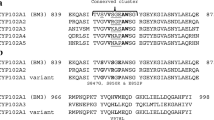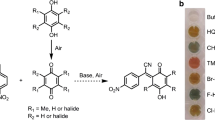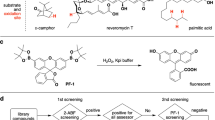Abstract
Cytochrome P450 BM-3 with the mutations A74G, F87V, and L188Q could catalyze indole to produce indigo and indirubin. To further enhance this capability, site-directed and random mutageneses on the monooxygenase domain of P450 BM-3 mutant (A74G/F87V/L188Q; 3X) were performed. The mutant libraries created by error-prone polymerase chain reaction were screened using a colorimetric colony-based method on agar plates followed by a spectroscopic assay involving in absorption of indigo at 670 nm and NADPH at 340 nm in microtiter plate. Three mutants (K434R/3X, E435D/3X, and D168N/A225V/K440N/3X) exhibited higher hydroxylation activity toward indole in comparison to parent enzyme. Moreover, using saturation site-directed mutagenesis at amino acid positions 168, 225, 434, 435, and 440, two P450 BM-3 variants (D168H/3X, E435T/3X) with an up to sixfold increase in catalytic efficiency (k cat/K m) were identified, and the mutant D168H/3X acquired higher regioselectivity resulting in more indigo (dimerized 3-hydroxy-indole) compared to parent mutant (93 vs72%).


Similar content being viewed by others
References
Bayer, A. (1878). Synthese des Indigblaus. Chemische Berichte, 11, 1296–1297.
Heumann, K. (1890). Neue Synthese des Indigos und verwandter Farbstoffe 1. Chemische Berichte, 23, 3043–3045.
Koehler, C. S. W. (1999). Synthetic dyes and the German chemical industry. Today’s Chemist at Work, 8, 85–94.
King, L. J., Parke, D. V., & Williams, R. T. (1966). The metabolism of [2-14C] indole in the rat. Biochemistry Journal, 98, 266–277.
Russell, G. A., & Kaupp, G. (1969). Oxidation of carbanions. IV. Oxidation of indoxyl to indigo in basic solution. Journal of the American Chemical Society, 91, 3851–3859.
Murdock, D., Ensley, B. D., Serdar, C., & Thalen, M. (1993). Construction of metabolic operons catalyzing the de novo biosynthesis of indigo in Escherichia coli. Biotechnology, 11, 381–386.
Ensley, B. D., Ratzkin, B. J., Osslund, T. D., Simon, M. J., Wackett, L. P., & Gibson, D. T. (1983). Expression of naphthalene oxidation genes in Escherichia coli results in the biosynthesis of indigo. Science, 222, 167–169.
Gillam, E. M. J., Aguinaldo, A. M., Notley, L. M., Kim, D., Mundkowski, R. G., Volkov, A. A., et al. (1999). Formation of indigo by recombinant mammalian cytochrome P450. Biochemical and Biophysical Research Communications, 265, 469–472.
Gillam, E. M. J., Notley, L. M., Cai, H., De Voss, J. J., & Guegerich, F. P. (2000). Oxidation of indole by cytochrome P450 enzymes. Biochemistry, 39, 13817–13824.
Nakamura, K., Martin, M. V., & Guengerich, F. P. (2001). Random mutagenesis of human cytochrome P450 2A6 and screening with indole oxidation products. Archives of Biochemistry and Biophysics, 395, 25–31.
Li, Q. S., Schwaneberg, U., Fischer, P., & Schmid, R. D. (2000). Directed evolution of the fatty-acid hydroxylase P450BM-3 into an indole-hydroxylating catalyst. Chemistry- A European Journal, 6, 1531–1536.
Narhi, L. O., & Fulco, A. J. (1986). Characterization of a catalytically self-sufficient 119,000-dalton cytochrome P-450 monooxygenase induced by barbiturates in Bacillus megaterium. Journal of Biological Chemistry, 261, 7160–7169.
Narhi, L. O., Wen, L. P., & Fulco, A. J. (1988). Characterization of the protein expressed in Escherichia coli by a recombinant plasmid containing the Bacillus megaterium cytochrome P-450 BM-3 gene. Molecular and Cell Biochemistry, 79, 63–71.
Appel, D., Lutz-Wahl, S., Fischer, P., Schwaneberg, U., & Schmid, R. D. (2001). A P450 BM-3 mutant hydroxylates alkanes, cycloalkanes, arenes and heteroarenes. Journal of Biotechnology, 88, 167–171.
Carmichael, A. B., & Wong, L. L. (2001). Protein engineering of Bacillus megaterium CYP102: the oxidation of polycyclic aromatic hydrocarbons. European Journal of Biochemistry, 268, 3117–3125.
Li, Q. S, Ogawa, J., Schmid, R. D., & Shimizu, S. (2001a). Engineering cytochrome P450 BM-3 for oxidation of polycyclic aromatic hydrocarbons. Applied Environmental Microbiology, 67, 5735–5739.
Peters, M. W., Meinhold, P., Glieder, A., & Arnold, F. H. (2003). Regio- and enantioselective alkane hydroxylation with engineered cytochromesP450 BM-3. Journal of the American Chemical Society, 125, 13442–13450.
Sambook, J., & Russell, D. W. (2001). Molecular cloning: a laboratory manual, 3rd edn. New York: Cold Spring Harbor Laboratory.
Vandeyar, M. A., Weiner, M. P., Hutton, C. J., & Batt, C. A. (1988). A simple and rapid method forthe selection of oligodeoxynucleotide-directed mutants. Gene, 65, 129–133.
Maurer, S., Schulze, H., Schmid, R. D., & Urlacher, V. B. (2003). Immobilisation of P450BM-3 andan NADP+ cofactor recycling system: towards a technical application of heme-containing monooxygenases in fine chemical synthesis. Advanced Synthesis and Catalysis, 345, 802–810.
Omura, T., & Sato, R. J. (1964). The carbon monoxide-binding pigment of liver microsomes. I. Evidence for its hemoprotein nature. Journal of Biological Chemistry, 239, 2370–2378.
Bernstein, F. C., Koetzle, T. F., Williams, G. J. B., Meyer, J. E. F., Jr., Brice, M. D., Rodgers, J. R., et al. (1977). The protein data bank: A computer-based archivalle for macromolecular structures. Journal of Molecular Biology, 112, 535–542.
Gunsteren, W. F. van., Billeter, S. R., Eising, A. A., Hünenberger, P. H., Krüger, R., Mark, A. E., et al. (1996). In biomolecular simulation: The gromos96 manual and user guide. Vdf, Hochschulverlag an der ETH; BIOMOS.
Sevrioukova, I. F., Li, H., Zhang, H., Peterson, J. A., & Poulos, T. L. (1999). Structure of a cytochrome P450-redox partner electron-transfer complex. Proceedings of the National Academy of Sciences, 96, 1863–1868.
McKee, T., & McKee, J. R. (2001). Biochemistry. McGraw-Hill, pp. 121–122.
Acknowledgements
This work was supported by the joint project of CSC (China)-DAAD (Germany) (2004c33036) and the National Natural Sciences Foundation of China (30570411).
Author information
Authors and Affiliations
Corresponding author
Rights and permissions
About this article
Cite this article
Li, Hm., Mei, Lh., Urlacher, V.B. et al. Cytochrome P450 BM-3 Evolved by Random and Saturation Mutagenesis as an Effective Indole-Hydroxylating Catalyst. Appl Biochem Biotechnol 144, 27–36 (2008). https://doi.org/10.1007/s12010-007-8002-5
Received:
Accepted:
Published:
Issue Date:
DOI: https://doi.org/10.1007/s12010-007-8002-5




